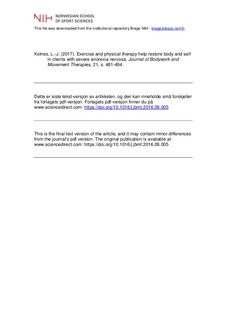| dc.contributor.author | Kolnes, Liv-Jorunn | |
| dc.date.accessioned | 2017-09-05T12:13:39Z | |
| dc.date.available | 2017-09-05T12:13:39Z | |
| dc.date.issued | 2017-07 | |
| dc.identifier.citation | Journal of Bodywork and Movement Therapies. 2017, 21, 481-494 | nb_NO |
| dc.identifier.uri | http://hdl.handle.net/11250/2453216 | |
| dc.description | I Brage finner du siste tekst-versjon av artikkelen, og den kan inneholde ubetydelige forskjeller fra forlagets pdf-versjon. Forlagets pdf-versjon finner du på www.sciencedirect.com / In Brage you'll find the final text version of the article, and it may contain insignificant differences from the journal's pdf version. The definitive version is available at www.sciencedirect.com | nb_NO |
| dc.description.abstract | Exercise in the context of anorexia nervosa is a multifaceted endeavour surrounded by controversy and uncertainty. A broader comprehension of this poorly understood phenomenon is required. Informed by the findings of a body examination of six individuals with anorexia nervosa, as well as exercise science, phenomenology and neurocognition, the purpose of this article is to elaborate on the potential role of exercise and physical therapy in the treatment of anorexia nervosa. The findings of the body assessment include constriction of posture, muscles and pattern of breathing. These bodily restraints are not necessarily merely associated with high levels of exercise, they may also reflect psychological strain accompanying the illness. The restricted breathing in particular is assumed to be associated with difficult thoughts and suppressed feelings. Based on the results of the body examination, as well as medical and psychological considerations accompanying the illness, it is suggested that interventions should focus on improving postural stability and restoring related muscular function. Integral to engaging in these activities, the potential to integrate proprioceptive information in this process may generate a more coherent experience of the body, as well as of the self, in these clients. Accordingly, constrictions of the body may have a vital role in constraining the experience of the self. As such, addressing bodily restraints in these clients may facilitate the experience of being the subject causing and controlling the movements. This is in marked contrast to clients' previous exercise experiences, which were associated with compulsion, rigidity and the absence of coherence and control. | nb_NO |
| dc.language.iso | eng | nb_NO |
| dc.publisher | Elsevier | nb_NO |
| dc.subject | anorexia nervosa | nb_NO |
| dc.subject | exercise | nb_NO |
| dc.subject | physical therapy | nb_NO |
| dc.subject | breathing pattern | nb_NO |
| dc.subject | postural stability | nb_NO |
| dc.subject | restore body and self | nb_NO |
| dc.title | Exercise and physical therapy help restore body and self in clients with severe anorexia nervosa | nb_NO |
| dc.type | Journal article | nb_NO |
| dc.type | Peer reviewed | nb_NO |
| dc.source.journal | Journal of Bodywork & Movement Therapies | nb_NO |
| dc.identifier.doi | 10.1016/j.jbmt.2016.09.005 | |
| dc.description.localcode | Seksjon for idrettsmedisinske fag / Department of Sports Medicine | nb_NO |
